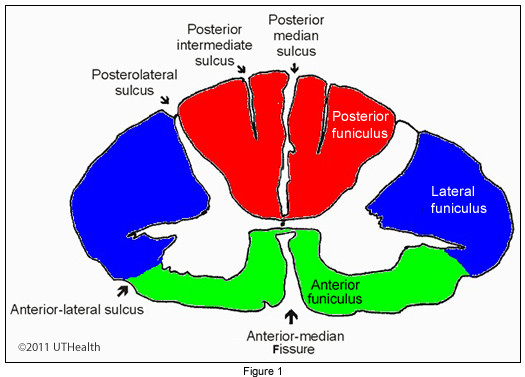Lab 6 (ƒ9) Descending Pathways to the Spinal Cord
Overview
 Recall from Laboratory Exercise 4 that the anterior horns contain groupings of large alpha motor neurons whose axons innervate somatic musculature. The neurons supplying a particular muscle or muscle group tend to be located in the same cluster or motor neuron pool. Medial groups innervate the trunk (proximal) musculature principally; laterally located cell groups innervate limb/digit (distal) musculature principally.
Recall from Laboratory Exercise 4 that the anterior horns contain groupings of large alpha motor neurons whose axons innervate somatic musculature. The neurons supplying a particular muscle or muscle group tend to be located in the same cluster or motor neuron pool. Medial groups innervate the trunk (proximal) musculature principally; laterally located cell groups innervate limb/digit (distal) musculature principally.
Motor neurons in the spinal cord are directly (monosynaptically) or indirectly (by way of spinal cord interneurons) influenced by axons in several different fiber tracts.
A "lateral" group of tracts descends in the lateral funiculus of the spinal cord (blue in figure) and primarily influences motor neurons (and their interneurons) in the lateral aspects of the anterior horn (green in figure). This group of tracts consists of the lateral corticospinal tract and the rubrospinal tract.
A second group of descending spinal pathways terminates largely on more medially situated motor neuron pools (and their interneurons). These tracts include the reticulospinal, vestibulospinal and tectospinal pathways.
Broadly speaking, the "laterally" terminating group is especially important for skilled movements of the distal extremities, i.e., fingers of the hand, whereas the "medially" terminating group is important for regulating posture and movement of proximal body parts. Individual axons of the "lateral" group terminate at only one or a few spinal segments, whereas those of the "medial" group tend to distribute axon collaterals to many segments along the length of the spinal cord. Lateral group controls small, discrete motor neuron pools for independent movement of small muscle groups such as of the fingers.
In this Exercise you will be following the course of the major descending spinal tracts. Since the internal capsule and pyramids are the only well delineated tracts, learn the approximate positions of the more poorly defined tracts in relation to these better-defined tracts.
An important point to keep in mind is that the motor neurons receive few monosynaptic inputs from the above mentioned descending spinal pathways; rather, these pathways exert their control on motor neurons indirectly via interneurons within the spinal cord grey matter. The exception to this is the lateral corticospinal tract that does contain many axons that make monosynaptic, excitatory connections onto alpha motor neurons. Another source of excitatory monosynaptic input onto alpha motor neurons is Ia muscle spindle afferents from homonymous and synergistic muscles.

